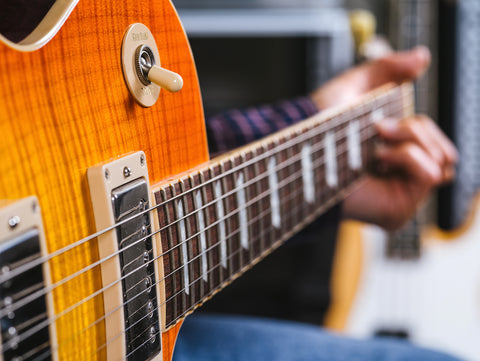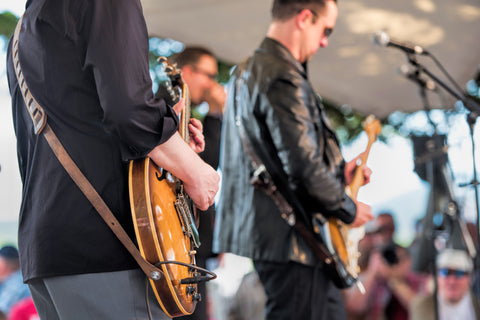-
Audio
-
Guitar
-
Bass
-
Blog
-
SALE
- Financing
- Support
- SINCE 1946
August 23, 2016
When you bought your tube amplifier a major factor was probably how good it sounded! You worked it hard for a long time and made a lot of great music with it, and then one day you noticed it just didn’t seem as awesome as you remembered it sounding. Or perhaps you were playing and one of the tubes died, leaving you wondering what it would take to bring it back to life? Sooner or later, every tube amplifier aficionado will have to face the confusing task of choosing replacement tubes for their amp. Let’s look at how you can sort through the hype, get the great sounding tubes you need and avoid paying more than you have to for them.
August 19, 2016
Most guitar players today can get by in a live situation with an amplifier that’s 50 watts or less, cranked up or even a 16 watt amp mic’ed up. However, most bass players need to come to the gig packing a little more power. Here we will look at how power fits into what you may need for your bass rig.
August 18, 2016

For gigging guitarists and bassists, packing for a gig means more than just loading up your instrument, amplifier, pedals, and cables into the car. It means preparing for a plethora of “what if” scenarios that may bring your gig to a grinding halt.
However, there are often-forgotten essentials that should find their way into your gig bag sooner rather than later.
August 16, 2016

When you decide to add effects to your guitar sound start by asking yourself “Do I want to change my sound? Or do I want to add something to my sound?”
Think about those old effects pedals that go between your guitar and the input of your amplifier. The signal goes from one pedal to the next in series. There is only one signal path from the guitar, through each of the pedals and on to the amplifier. On the other hand, when your engineer turns up the delay send on your guitar channel at the mixer, part of your sound is sent to the delay processor and then returned to the mixer but the main signal still runs dry [unaffected] through your channel, so you hear a mix of the two in the main speakers. Parallel effects systems allow you to blend your sound with the effect.
August 11, 2016

When purchasing a bass cabinet, there are many factors to consider, such as speaker configuration, size, weight, power handling, portability, and of course, how it sounds. However, a somewhat overlooked component of a speaker enclosure’s overall sound is whether it is sealed or ported. Both cabinet formats have their own benefits and drawbacks, and this article will cover the basic differences and help you determine which one will be the optimal choice for your bass amp setup.
July 26, 2016
If you play guitar or bass a lot, chances are you go through a lot of strings. In a previous article we discussed how to know when it’s time for you to change strings. But what do you do with your old strings? While simply tossing them in the trash is the most straightforward option, there are numerous alternatives that are worth a try.
July 21, 2016

So, you’ve finally assembled the pedalboard of your dreams. Your tone and settings are dialed in, and you’re ready to take it onstage. However, before you do, you need to find the best way to power everything up. Fortunately, in this day and age, there are suitable pedal powering options for nearly every budget and pedalboard configuration. This article will explore the main choices and help you find which solution is best for your setup.
If you only have a few pedals and aren’t gigging too heavily, a simple...
July 14, 2016

The quest for tone can take you to many places, and when it comes to overdrive, the ideal tone may reside in a specific pedal, amp, or a combination of both. Experimentation is key, as is knowing the limitations of your equipment.
Many guitarists set their amp for a clean tone and use a pedal of choice to send the clean channel into overdrive. This simple, practical setup lets you kick on the grit of your choice when the song calls for it. This method lets you use your amp as a clean palette to sculpt your overdrive tone. While straightforward, this setup is not without its setbacks. Your clean channel and overdrive will share the same EQ settings, which may not be a big deal if your pedal has its own EQ controls. However, many popular overdrive pedals do not feature the same EQ versatility as amps (for instance, they may have only gain, volume, and tone controls) so the overall tweak ability between clean and dirty is somewhat limited. If you like the baked-in tone of the pedal a lot, then this setup may work well for you. In many multiple channel amplifiers the clean channel and the lead or dirty channel have very different gain stages, internal tone shaping and even EQ control circuits to produce the intended clean or dirty tone. Instead of driving your clean channel with your pedals, try using your dirty channel with the gain set a little lower. This will give you the better tone shaping and EQ controls for dirty sounds and a little more headroom to handle your pedal for more dynamics. Often pedals are tried with the same settings you would use to get the same level of dirty tone without the pedal and adding the unit creates mud, so you switch to the clean channel. Turn down your gain a little and try it again. Then you still have a clean channel to use and EQ for clean playing. The added bonus is a third slightly lower distortion with your dirty channel only.
Another popular way to achieve a rich, gritty overdrive is to crank the overdrive channel of a tube amp. This really gets your tubes working, which results in what many consider to be a more organic, dynamic distortion than what pedals can provide. However, many tube amps, especially high wattage amps, require more volume to reach the desired level of saturation than is practical. For this reason, many amps, like the Carvin Audio V3, have switchable wattage, so you can get a crunchy tone at a much lower volume.
Most modern dense distortion sounds are pre master preamp gain distortions. With pedals, these overdrives are not as smooth as an amp that is designed to be a hi-gain amp. This smoothness is usually from the high voltages and signal swing of the amplifiers as opposed to the pedal creating more dynamic and tone in the signal. Here you just have to try different combinations. Again lowering the input gain on the amp a little and using the pedal for the solo sustain edge can create more dynamics. The Carvin Audio V3, V3m and Legacy have two lead channels that are identical, so you can create a rhythm tone and a high gain and sustaining lead tone to switch between.
Legacy 3 100W 3 Channel All Tube Head
Side note: Remember when playing in the band you are just one of the instruments putting out sound. If you tweak your tone at home alone, you maybe unknowingly also filling for the rest of the band. A good solid tone needs to cut through the band, but it also needs to let the other sounds of the band be heard. With loads of distortion you will be a small non-distinctive buzz in the overall sound of the band, and with really fat low and high tone you will sonically fight with the rest of the band.
In many cases, it may be the exclusive use of a particular tube amp or pedal that will get you the perfect overdriven guitar sound that’s in your head. Killer tone can be the result of combining an amplifier’s natural tube breakup with a hot signal from an overdrive or distortion pedal, which can also act as a preamp or clean boost to further push and shape the overall tone. There are many shades in between clean and dirt to be explored. Feel free to take your time and experiment with all the different options available. If it sounds good to you, it is good!
July 07, 2016
No matter how good you are at your instrument, your playing will still sound bad if you're out of tune. It goes without saying that investing in a quality guitar tuner is essential to sounding your best.
July 01, 2016

Knowing how to intonate your instrument is an essential part of setting it up to play optimally. Intonation is basically how well your guitar stays in tune with itself across the length of the fretboard. If all your strings are tuned correctly, but notes or chords played higher up on the fretboard sound off pitch, then you definitely need to adjust your intonation. Fret not- it’s a fairly simple process that this guide will walk you through step by step!
June 29, 2016

There are thousands of effects pedals on the market today to choose from to sculpt your tone, and within that myriad of choices lies another one: buffered vs. true bypass. Ask a group of guitarists what their preference is, and you’ll likely get a bunch of responses favoring either one. This article will introduce the basic science behind buffered and true bypass pedals.
June 21, 2016

An important decision you may have to make when considering a new guitar amp is whether you want a rackmount setup or a traditional guitar amplifier head or combo. You probably know the drill with guitar heads and combos (if not, catch up on your reading by clicking here).
Sign up to get the latest on sales, new releases and more…
NoFraud Frequently Asked Questions
"Make a joyful noise unto the Lord all of the earth; make a loud noise and rejoice and sing praises. Sing to the Lord with the harp and the voice of the psalm." - Psalm 98:4-5
© 2025 Carvin Audio.
Carvin Corp.
POS and Ecommerce by Shopify
